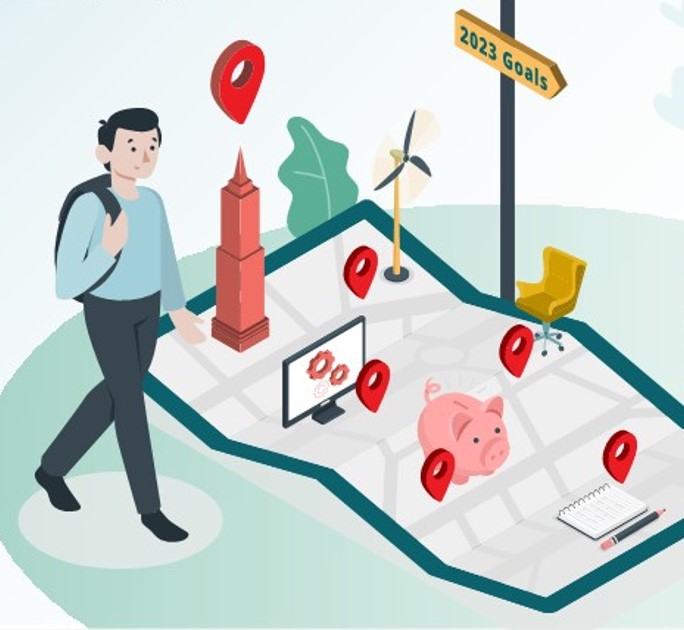Business Outlook 2023: SME Opportunities Amid Challenging Global Economy

With global headwinds rising, a rocky road lies ahead for Singapore’s businesses in 2023. High inflation, mounting interest rates, supply chain disruptions, and a worldwide economic slowdown all add up to a perfect storm of growth challenges for businesses.
To help SMEs weather the storm, DBS partnered with the Singapore Business Federation to organise the Seminar on Business Outlook 2023. During the seminar, Irvin Seah, Executive Director and Head of Strategic Projects and Content Management, Group Research at DBS Bank, together with fellow speakers and panellists, analysed the global economic outlook for 2023 and highlighted opportunities for Singapore businesses to thrive. Here’s a recap of the key insights.
Interest rate hikes will slow as global inflation eases
On a global level, soaring inflation has driven interest rates to historic highs as the world’s central banks hiked rates aggressively. In December 2022, the US Federal Reserve raised its benchmark interest rate to its highest since pre-Global Financial Crisis levels.1 The result has been a trade slowdown and concerns regarding repayment amid record highs in global debt ratios, driving operating costs up for businesses.
Nonetheless in 2023, businesses can look forward to light at the end of the tunnel. “Global inflation has peaked and is abating, and consumer prices have peaked as well,” observed Irvin in his keynote on the ‘Global and Singapore Economic Outlook for 2023’. “In response, the US Fed is expected to ease off hikes during its upcoming meeting in February.”
The question of a US recession has been hotly debated, but Irvin foresees that the US will avert a technical recession. “Our forecast from DBS Bank’s chief economist is 0.3% GDP growth for the US this year – narrowly avoiding a full-on recession,” he shared. “Nevertheless, businesses on the ground will still feel the pinch.”
Zooming in on ASEAN, a similar trend is taking shape. Headline inflation has begun to ease from multi-year highs for ASEAN economies like Singapore. Meanwhile, core inflation pressures “remain sticky but will be contained,” Irvin predicted.
ASEAN-6 countries have experienced a robust economic recovery post-pandemic, but this will slow somewhat in the year ahead. After an average GDP growth of 6% in 2022, ASEAN will see a forecasted dip in growth to 4.6% in 2023, before rallying to 4.9% in 2024.
China’s reopening will spur growth for ASEAN businesses
China’s zero-COVID policy has put it behind the curve for post-pandemic recovery, and its recent border reopening has brought cheers from businesses across Asia. A new wave of Chinese tourists is set to unleash 5.6 trillion yuan in pent-up savings,2 providing a much-needed boost to the world economy.
However, Irvin warned of three key hurdles to China’s rebound. Firstly, China will have to battle multiple waves of COVID-19 outbreak after dismantling its containment policies.
Secondly, China’s consumption recovery will be constrained by slowing income growth. “Income and expenditure per capita have dropped, and many people have lost their jobs. Future income confidence is also at a record low,” he explained. “It’ll take time for people to see their income improving and thus be willing to spend more.”
Finally, any easing in China’s monetary policy will see some lag time. Inflation remains low, providing room for the People’s Bank of China (PBOC) to loosen monetary policy and spur economic growth if required. “However, this can only happen after the Fed has paused hikes – if not, the interest rate differential will weaken the Chinese yuan,” Irvin emphasised. “This means that ASEAN companies will only feel most of the uplift from China’s reopening in the second half of this year.”
ASEAN will certainly be the key beneficiary of China’s reopening. Not only is China the largest export market for ASEAN, Chinese travellers have also been a key driver of tourism revenue in markets like the Philippines, Singapore, Thailand, and Vietnam. From manufacturing to hospitality, ASEAN businesses can look forward to a shot in the arm.
Singapore’s economic growth is slowing – but surprises await
With Singapore’s growth slowing to 3.8% in 2022,3 it’s no surprise that businesses are looking ahead with greater caution. According to the Singapore Business Federation’s National Business Survey 2022/2023,4 26% of businesses foresee the economy worsening in the next 12 months.
For certain sectors, the outlook has darkened. The manufacturing sector is in recession, with Singapore’s Non-oil Domestic Exports (NODX) plunging 20.6% in December 2022.5 Irvin pinpoints two contributors for this: plummeting demand resulting from a global slowdown, and China’s zero-COVID policy. “China accounted for 17.6% of our NODX in 2021,” he said. “Singapore’s manufacturing outlook will be shaped by how fast China can resume normal economic activity.”
The services sector has seen a strong recovery since Singapore’s reopening, but momentum is waning. The exception is hospitality, which will feel the uplift from China’s reopening “as early as the second quarter of 2023,” Irvin predicted.
Due to the GST hike, inflation will remain sticky in 2023, driving higher operating costs for businesses. After spiking this January, Irvin anticipates headline inflation to ease from the second quarter of the year. Meanwhile, core inflation will remain fairly stable at around 4% throughout the year. Consequently, the Monetary Authority of Singapore (MAS) will likely put the brakes on monetary tightening – though interest rates will stay high in the short term.
Overall, GDP growth will slow to an estimated 2.2% this year. “We are a bit below the long-term potential growth range of 2.5% to 3.5%,” Irvin shared. “But with China’s reopening, I don’t discount the possibility of upside surprises for Singapore in the second half of 2023.”
Sustainability is becoming a key business imperative
As Singapore embarks on its Green Plan 2030,6 SMEs will face stronger impetus to become sustainable.
During the seminar, panelists highlighted that businesses will need to prepare for higher carbon tax rates and more stringent ESG requirements. As governments and leading banks make sustainability a priority, a strong sustainability strategy can open the door to reduced business costs and greater resilience.
SBF’s National Business Survey 2022/2023 reveals that 72% of Singapore SMEs have implemented at least one ESG area, and 78% feel well-prepared or somewhat prepared for a low-carbon transition. Yet 39% of SMEs still don’t know how or where to start, and 28% lack a clear strategy to drive the transition.
For SMEs just starting their sustainability journey, the first step lies in getting a solid understanding of their current performance. By measuring baseline data, businesses can then identify areas of improvement and develop clear sustainability goals, drawing on recognised standards like ISO.
Green opportunities are rising for Singapore businesses
While the shift to sustainability may pose a challenge for SMEs, it will also open up new access to financing and more efficient technologies.
For one, China’s commitment to decarbonisation will drive down the manufacturing costs of many newer green technologies in the near future. As China progresses in manufacturing and exporting essential technologies such as EV batteries and solar panels, its manufacturing scale will be instrumental in reducing the cost of these innovations.
For businesses abroad, this means better access to energy-efficient solutions at a cheaper price. India, for example, has been making huge strides in solar power, thanks to a 90% decrease in the cost of importing Chinese solar panels over the last decade. As Singapore embarks on its plans to import renewable energy, much will depend on a reduction in unit costs of the underlying technology as well.
Another key opportunity for SMEs lies in sustainable financing. With Singapore positioning itself as a green finance hub in the region, businesses can look forward to more creative structuring of financial products from leading banks. This includes calibrated business loan interest rates for sustainability loans, along with financial benefits for promoting social good.
Staying prepared in an evolving landscape
There’s no doubt that a bumpy ride lies ahead in 2023. But SMEs in Singapore can stay prepared to thrive with a strong understanding of global and regional macro-trends and the opportunities they bring.
Watch the event highlights video below.
Find out how DBS can partner with you to provide industry insights and advice in a fast-evolving landscape. Get in touch with us today.
References:
[1] CNBC, Fed raises interest rates half a point to highest level in 15 years, Dec 2022
[2] Bloomberg, China’s Reopening Is the Boost the Flagging World Economy Needs, Jan 2023
[3] Ministry of Trade and Industry Singapore, Singapore’s GDP Grew by 2.2 Per Cent in the Fourth Quarter of 2022 and by 3.8 Per Cent in 2022, Jan 2023
[4] Singapore Business Federation, National Business Survey 2022/2023
[5] ING, Singapore: NODX dips for a third straight month, Jan 2023
[6] Channel NewsAsia, Singapore unveils Green Plan 2030, outlines green targets for next 10 years, Feb 2021



